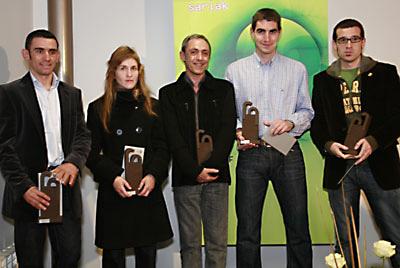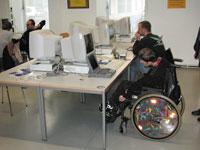Home appliances like playing jazz more than playing the symphony
2008/04/01 Urbieta Artetxe, Aitor - IKERLANeko ikertzailea eta Mondragon Unibertsitateko doktoregaia Iturria: Elhuyar aldizkaria
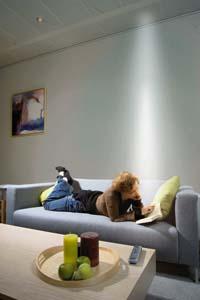
But despite being an infrastructure to achieve the goal set by Weiser, we still have a long way to go. The most important reason is that each device acts as an independent island, offering a specific and limited functionality, but without possibility of collaboration [3].
The article described below is articulated as follows: first, as an example, the differences between a smart and a non-intelligent home are described, and then the main challenges that are observed in this example are described.
Smart Home of the Future
Mikel and Ane live in Aramaio, but their home is full of invisible sensors, artificial vision cameras and equipped with the most modern appliance on the market. These devices, and above all their intelligence, allow to carry out the behaviors described below, through the collaboration between appliances, cameras and sensors. Below are some cases, first the house without intelligence and then the smart house.
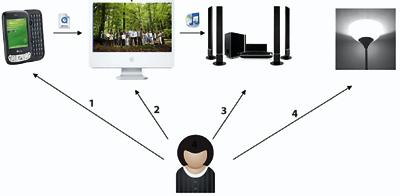
The case of the house without intelligence
Mikel, as always, has left work and gone home. Since there has been no one at home during the day, the house is cold. So you started heating. You want to listen to music similar to the one you were listening to on your iPodTouch and it turns on your computer and connects to last.fm to choose the music you like most. He has put the music in the living room, but then, when he goes to the kitchen, he has had to turn off the speakers of the living room and turn on those of the kitchen and re-choose his favorite music in his musical apparatus.
Soon after Ane arrives home and, after leaving her jacket and bag in the coat rack, sits in the lounge seat with the intention of continuing to see the Balbemendi series she was watching on the bus. To do this you had to pass the video file of your player to the computer of the living room through the wi-fi network and open the section of the series in the VLC application. It then launches the Home Cinema and finally connects the output of the computer to listen to the sound of the series. As it stands, the intensity of the light in the living room has dropped, as it prefers to watch the TV in low light.
Meanwhile, Mikel prepares dinner. M.D. House calculates the start time of the series and realizes that it has been delayed. Before starting the series wanted to hang clothes, but well, you will have to hang up after finishing the series. So you have started the washing machine. As the washing machine is very noisy, when you raise the volume of the speakers and sound the phone has not noticed. Ane stops seeing her series for a moment and comes from the living room telling her she is touching the phone. Mikel grabs the phone, but as she was preparing dinner, she runs and talks to her parents in haste. He has forgotten to write his mother's obligation and, worse, he has burned the potato omelette that was still burning.
The case of the smart house
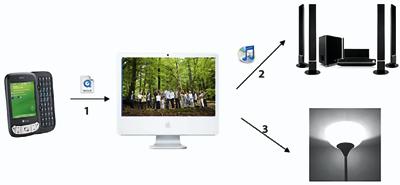
Mikel, as always, has left work and gone home. Learning the house over time, he knows that the temperature Mikel likes is twenty degrees and keeps his house automatically at that temperature. Also, depending on the time of year, open or close the windows, turn on the air conditioning or place the heating to get the desired temperature. Since there has been no one at home all day, the heating has been turned on. When Mikel comes home, on her iPodTouche she listened to music, the house has noticed it and connected to Mikel's last.fm profile to see what her favorite music is. Finally, he has broadcast the music by the speakers closest to Mikel. As Mikel moves, the sound also changes place throughout the house.
Soon after Ane arrives home and, after leaving her jacket and bag in the coat rack, sits in the lounge seat to continue watching the Balbemendi series she was watching on the bus. As it has done in the last two weeks, the house has learned this behavior. Therefore, instead of configuring Ane manually, the image of the series you were viewing on the PDA has been put on the computer screen of the salon and the sound also in the Home Cinema. In addition, the intensity of the light has decreased and the doors of the living room have been closed so that Ane can enjoy with peace of mind his favorite series.
As Mikel prepares dinner, the washer dryer is launched and today House M.D. You will see that the washer dryer will end 15 minutes before the start of the series. This way they can have collected garments to start the series. At the same time that the washing machine has been launched, the volume of the kitchen speakers has risen so that Mikel continues to listen correctly. In addition, the special notice mechanism of the phone has been launched, which allows that if someone calls by phone, it will sound in the room in which Mikel is, but not in the room in which Ane is. Before the end of the dinner preparation, the phone rings and the name of the caller is heard from the speaker. At the same time that Mikel has accepted the call, the music has stopped to be able to talk quieter with speakers and microphones from the kitchen. By the way, he had the opportunity to continue with dinner, as he had his hands free.
Intelligent environment analysis
As can be seen in previous cases, the advantages that smart home can bring are many, especially for adults, but also for other people. In the first case it can be observed that it is the user who has the initiative, who has to manage and launch the necessary devices to achieve the desired goal. In the end you waste a lot of time to do something simple. But in the second case (smart home) the initiative is held by the devices; without the user doing anything, the devices are coordinated to meet the needs of the user. The ultimate goal is to adapt the environment to the needs of the user.
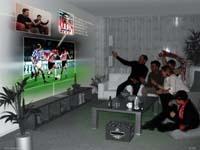
The previous casuistry can be assimilated to the types of music. Symphony or Jazz? in the book [6]. Koldo says that improvisation predominates in jazz, that there is initiative and that in the end a harmonic result is achieved. In jazz creativity is perceived, each musician is able to play his instrument and know how others play it, they are creating music at all times and yet there is no director. It is a team that generates innovation. In the classical orchestra it is repeated and the musicians perform a score that is not theirs. They play a score directed by a director, there is no chance of improvisation.
If we apply what Koldo Saratxaga says to the case of the house, it is evident that the house without intelligence is a kind of symphony: there is a director, a user, and the musicians are devices, each plays his instrument and part of the score, but he is not able to improvise and act. In the case of the smart house, however, there is no director, but the result is the same that they get between devices: they are able to improvise, to create new interactions, to create new behaviors not previously raised, and above that, to obtain a harmonious result. In addition, devices have the initiative and do not need a great user involvement.
We are still far from getting the smart home described above, as it is necessary to avoid certain needs in order to achieve these intelligent behaviors between devices. In the world of research, this collaboration between devices is known as the composition of services, which requires different paradigms and methodologies to obtain them.
Sensitivity to context
The devices that we can currently find in our environment do not adapt to user preferences, but always act in the same way. But that doesn't have to be so. Devices around the user must adapt to their status, location, etc. [1], being sensitive to changes in information in the environment, that is, each device must be able to know what is in its environment (nearby devices, services they offer, close people, state of them, etc.) and how environment information changes. In this way the services offered to the user can be dynamically adapted, for example, depending on the location of the user one or another light will be switched off. This adaptation to the context will be advantageous for the user as it will offer the most appropriate services to their location and preferences. In this way, the paradigm of interaction between users and applications changes radically: it is not the user who adapts to the applications but the applications according to the context of the user.
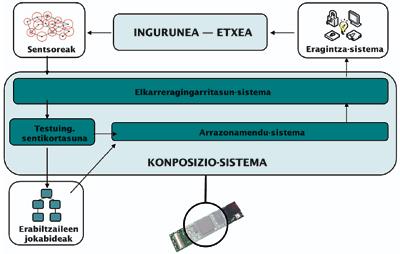
The existing information in the environment, both obtained by the sensors (temperature, light intensity, user location, etc.) as other information (services offered by surrounding devices, user preferences, etc.) is diverse, separate and ununified. Therefore, this information must be correctly managed and defined. To do this, it is necessary to define the context model, modeling the existing information in the environment, both sensor and other. With this objective, in recent years different technologies and methodologies have been proposed (graphic models, entity relationship models, logical models, etc. ), but all of them have been shown that ontologies are the most appropriate [5].
Interoperability system
The most important feature of ubiquitous computing environments is device mobility. As a result, it can be said that the environment is dynamic and very open, and that it is necessary to deploy and execute instantly the services offered by devices located in this type of environment, integrating at the right time and place the software and hardware existing in the environment. To achieve this dynamism, devices must be seen as an autonomous and independent resource.
The paradigm of Service-Oriented Architecture (PCS), very consistent with this idea, is especially appropriate, since in this paradigm the applications and devices that support them are defined as vulnerable services. This means that the services of each device are generated independently, without dependence on the services of other devices. In this way, initially unrelated services can join one by one to create high-level services, and in the case of the smart home, simple services (turning on the light, lowering the blinds, turning on the TV, closing the door) can join together to create more complex and complete services (when the user first enters the house, turning on the light, then lowering the blinds, closing the entrance door and then turning on the TV to the living room). Today, most systems using Service-Oriented Architecture use web services as an implementation.
With the paradigm of Service-Oriented Architectures we achieve a collaboration between devices that use the same technology, but this is not enough, since the devices that can be found in the environment can use different technologies: UPnP, web services, semantic web services, etc. This should allow interoperability between devices using different technologies, so that devices using different technologies could communicate with each other, for example, in the image above, the services offered by devices (each piece of the puzzle is the service offered by a device) are complementary, that is, they can be combined to achieve more complex behavior (and thus create a puzzle).
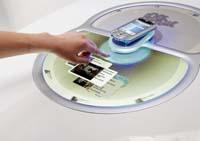
Reasoning system
This section is the most important part of the compositional system, since the intelligence of the system is located here, but it would be nothing without the two previous systems. The reasoning system is able, thanks to a system of sensitivity to the context, to know what each device has in its environment, that is, where is Mikel, whether the television is on or not, etc. On the other hand, the interoperability system allows communication with existing devices in the environment. It seems that the device is capable of composing, but for this it must be able to make decisions, that is, to know when it should compose and with what other device should communicate.
To this end, the compositional system needs a subsystem that allows to know the behavior of users, learning and modeling the behaviors that the user has had lately. Environmental information is essential for this, as can be seen in the following examples:
- Ane's PDA device has learned that most of the times she enters the house the series she was watching at the time passes to the computer in the room.
- Television has also learned that Ane in the afternoon passes a video from a PDA to the computer to watch it.
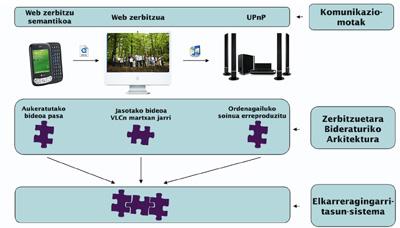
- The lamps and lights in the living room also know that Ana likes to have a single light, and especially in the afternoons when she returns from work.
The information used in the previous examples is very varied, on the one hand the positioning system in the home has been used and, on the other, the electronic agenda of Ane, the system of locating devices in the environment, etc.
When each device is able to find out when it has to act and knows what the overall behavior of the user is, we just need to work together, we agree on which service should be run after and before, in this way it will be possible to create complex behaviors between the devices and be closer to the ubiquitous computing goals defined by Weiser.

Gai honi buruzko eduki gehiago
Elhuyarrek garatutako teknologia




